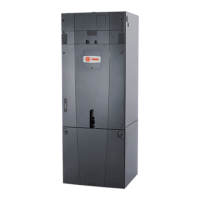MSDS – CS1000
Effective 5-1-2012
Page 4 of 6
10. STABILITY AND REACTIVITY
GENERAL STABILITY: This product is stable at ambient temperatures and atmospheric pressures.
INCOMPATIBLE MATERIALS: Strong acids, strong reducing agents, ammonia salts, amines, phthalic
acid and cyanides.
HAZARDOUS POLYMERIZATION: Hazardous polymerization is not expected to occur under normal
temperatures and pressures.
HAZARDOUS DECOMPOSITION PRODUCTS: Oxides of nitrogen. May leave a caustic residue.
11. TOXICOLOGICAL INFORMATION
Product CS1000 Metaborate Nitrite Metasilicate
Eye irritation: Severe to corrosive Slight to moderate Slight to moderate Corrosive
Skin irritation: Severe to corrosive Slight to moderate None to slight Corrosive
Inhalation irritation: Slight to moderate None to slight None to slight Corrosive
Oral LD
50
, Rat: > 1659 mg/kg 2330 mg/kg 120 mg/kg 1153 mg/kg
Dermal LD
50
, Rabbit: > 771 mg/kg 2000 mg/kg NDA NDA
Inhalation LC
50
, Rabbit: NDA NDA 1.45 mg/l NDA
Other toxicological data: NA See below See below See below
Metaborate: [Reproductive/Developmental Toxicity] Animal feeding studies in rat, mouse and dog, at high doses, have demonstrated effects
on fertility and testes. Studies with the chemically related boric acid in the rat, mouse and rabbit, at high doses, demonstrate
developmental effects on the fetus, including fetal weight loss and minor skeletal variations. The doses administered were many times in
excess of those to which humans would normally be exposed. [Human Data] Human epidemiological studies show no increase in
pulmonary disease in occupational populations with chronic exposures to boric acid dust and sodium borate dust. A recent epidemiology
study under the conditions of normal occupational exposure to borate dusts indicated no effect on fertility.
Nitrite: Tests in animals demonstrate no carcinogenic activity, or reproductive or developmental toxicity. Sodium nitrite appears to cross the
placenta causing methemoglobinemia in the fetus after administration to the dam. In some tests, but not in others, the compound
produced genetic damage in bacterial and mammalian cell cultures, as well as in tests in animals. It does not produce heritable genetic
damage.
Metasilicate: [Acute Dermal Toxicity] 250 mg/24 hr. skin human severe.
12. ECOLOGICAL INFORMATION
Product CS1000 Metaborate Nitrite Metasilicate
96 hr LC
50
, Rainbow trout: > 5565 mg/l 88 mg/l 0.19 mg/l NDA
48 hr LC
50
, Daphnia magna: > 7475 mg/l 242 mg/l 66 mg/l NDA
72 hr EC
50
, Algae: > 45 mg/l 24 mg/l NDA NDA
13. DISPOSAL CONSIDERATIONS
US EPA RCRA Status: This product is considered to be a hazardous waste.
US EPA RCRA Hazardous waste code: D002
Do NOT dump into any sewers, on the ground or into any body of water. Rinse containers before
disposal. Since emptied containers contain product residue, follow label warnings even after container is
emptied. Dispose in accordance with all applicable federal, state and local laws and regulations.
14. TRANSPORT INFORMATION
The data provided in this section is for information only. Please apply the appropriate regulations to
properly classify your shipment for transportation.
US DOT
Proper Shipping Name: Corrosive Liquid, Basic, Inorganic, n.o.s., (Sodium Metaborate
Octahydrate)
Hazard Class: 8

